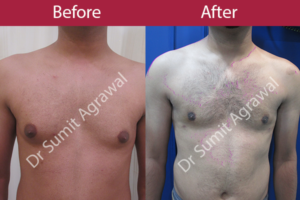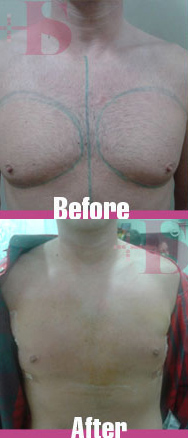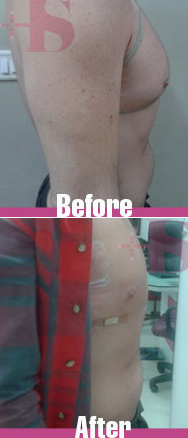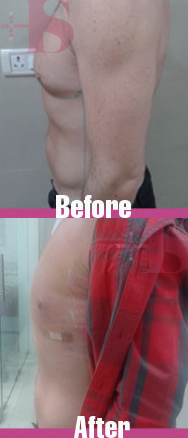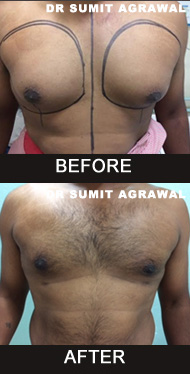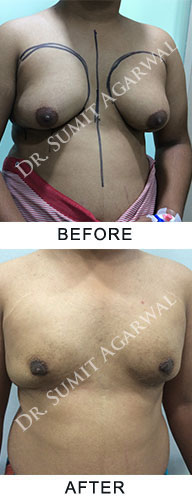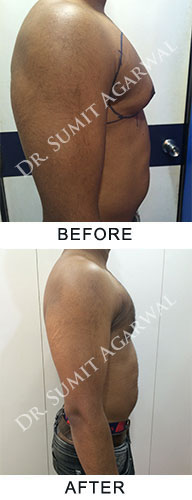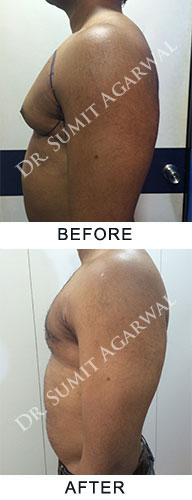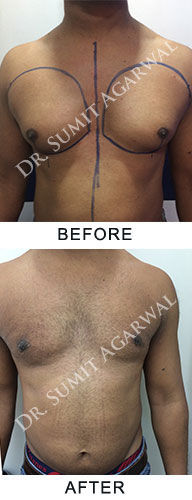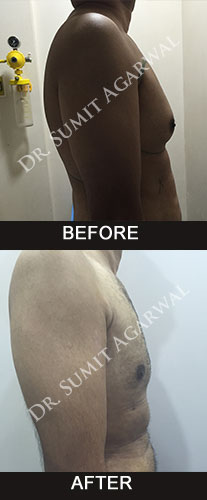Gynecomastia (Male Breast)
Introduction: Gynecomastia, often referred to as ‘Women-like Breast,’ is a medical condition characterized by abnormal male breast enlargement. It’s more common than you might think, affecting up to two-thirds of pubescent boys and half of all men. This condition can affect one or both breasts. For those seeking a solution, Gynecomastia Surgery in Mumbai offers an effective and reliable treatment option.
Understanding Gynecomastia: Gynecomastia is primarily caused by the presence of excess breast tissue in males. While breast glands exist in both genders, they are typically underdeveloped and not visible in males. However, for those suffering from gynecomastia, this can result in swollen or enlarged breasts.
What Are the 3 Grades of Gynecomastia?
Gynecomastia, a medical condition characterized by the enlargement of male breast tissue, is categorized into three grades, which help determine the appropriate treatment approach:
- Grade I Gynecomastia (Mild): In this stage, there is mild breast enlargement, typically with minimal excess tissue. The chest retains a relatively normal appearance, and the enlargement is often barely noticeable.
- Grade II Gynecomastia (Moderate): At this level, moderate breast enlargement occurs. Additional tissue extends to the edges of the chest, resulting in a more pronounced appearance of enlarged breast tissue.
- Grade III Gynecomastia (Severe): Grade III represents the most advanced stage of gynecomastia. It involves severe breast enlargement with a significant amount of excess tissue. This excess tissue often sags over the chest, significantly altering the chest’s appearance.
The severity of gynecomastia is crucial in guiding treatment decisions. While milder cases may respond to medication, more advanced cases, particularly Grade III, often necessitate surgical intervention for the best results.
Is Gynecomastia a Serious Problem?
Gynecomastia, often referred to as “women-like breast,” is a medical condition characterized by the enlargement of male breast tissue. It is generally not considered a physically harmful condition; however, it can have significant emotional and psychological effects on those affected, causing distress and a decrease in self-esteem. Gynecomastia can lead to feelings of self-consciousness and may affect a person’s quality of life, particularly in social and intimate situations.
It is essential to recognize that gynecomastia is a medical condition that can be effectively addressed through various treatments. These treatment options can help individuals reduce breast tissue enlargement, alleviate emotional distress, and improve their chest appearance. The severity of gynecomastia varies, and the choice of treatment depends on factors such as the individual’s age, the degree of breast enlargement, and underlying causes.
Seeking consultation with a qualified healthcare professional, such as a gynecomastia surgeon, is the first step toward understanding the condition and exploring treatment options. With appropriate medical guidance and treatment, many individuals experience significant improvement in their gynecomastia, ultimately leading to increased self-confidence and an enhanced quality of life.
Is It Chest Fat or Gynecomastia?
Distinguishing between chest fat and gynecomastia can be a challenging task, especially when relying solely on visual cues. A thorough medical evaluation is crucial to accurately determine the underlying cause of breast enlargement.
Gynecomastia, often referred to as “women-like breast,” is a medical condition characterized by the enlargement of male breast tissue. On the other hand, chest fat is related to excess adipose tissue in the chest area. While both may manifest as chest enlargement, their origins and characteristics are distinct.
Gynecomastia typically results from an overgrowth of glandular breast tissue, which can cause the breasts to appear swollen or enlarged. In contrast, chest fat arises from the accumulation of excess fat in the chest region.
A healthcare professional or specialist can perform a physical examination, assess your medical history, and, if necessary, order diagnostic tests like hormone level assessments or imaging studies to determine whether your condition is due to gynecomastia or chest fat. This evaluation is essential because the treatment approaches for gynecomastia and chest fat differ significantly.
In summary, when faced with the question of whether you have chest fat or gynecomastia, seeking a medical evaluation is the best course of action. A qualified healthcare provider can provide an accurate diagnosis and guide you toward the appropriate treatment, whether it involves addressing gynecomastia through surgery or implementing lifestyle changes to manage chest fat.
Top of Form
Gynecomastia in Different Life Stages:
- Teenagers: Gynecomastia can often arise during puberty due to hormonal imbalances in some boys. This condition is characterized by the development of excess breast tissue. The good news is that in approximately 90% of cases, gynecomastia naturally resolves without the need for medical intervention. It’s part of the natural hormonal fluctuations that occur during adolescence.
- Older Men: As men age, hormonal shifts, particularly a decrease in testosterone levels, can lead to the development of gynecomastia. Approximately 25% of men aged 50 to 80 may experience this condition. While gynecomastia in older men isn’t typically a serious medical concern, it can sometimes lead to discomfort or tenderness in the breast tissue. If you notice such changes, consulting a healthcare professional is recommended to determine the most appropriate action.
Signs and symptoms of Gynecomastia
Gynecomastia is characterized by the presence of specific signs and symptoms that affect the male breast area. The most common indicators include:
- Breast Swelling: Gynecomastia often leads to noticeable swelling of the breast tissue. This swelling can range from subtle to more pronounced, depending on the severity of the condition.
- Breast Tenderness: Many individuals with gynecomastia may experience tenderness or soreness in the affected breast area. This discomfort can vary in intensity and may be a source of concern.
- Discomfort Variability: The levels of discomfort associated with gynecomastia can vary from person to person. While some individuals may report mild discomfort, others may experience more significant levels of pain or tenderness.
- Breast Enlargement: In addition to swelling, the affected breast(s) may appear enlarged or fuller than normal. The extent of enlargement can vary from mild to more significant, and it may affect one or both breasts.
- Nipple Changes: Gynecomastia can sometimes cause changes in the nipple area. This might include the nipple becoming more prominent, puffy, or projecting differently than usual.
- Asymmetry: Gynecomastia may result in breast asymmetry, where one breast is more affected than the other. This unevenness in size or shape can be a noticeable sign.
- Psychological Impact: While not a physical sign, gynecomastia can have a psychological impact on individuals. Many people with this condition may feel self-conscious, anxious, or distressed due to the changes in their breast appearance. This emotional response is an important aspect of gynecomastia to consider.
- Duration: Gynecomastia can be either acute (short-term) or chronic (long-term). Understanding the duration of the condition can provide additional diagnostic insights.
Causes of Gynaecomastia
Hormone Imbalance:
- Gynecomastia often results from an imbalance between the male sex hormones, testosterone and estrogen. In males, testosterone is the dominant hormone responsible for the development and maintenance of male characteristics, including lean muscle mass and a deep voice. On the other hand, estrogen is the primary female sex hormone. It’s present in small amounts in men, produced primarily in fat cells and the testes. When there is an increase in estrogen levels or a decrease in testosterone levels, it can trigger the growth of breast tissue.
- Hormone imbalance can occur due to various factors, including medical conditions, medications, and lifestyle choices. Certain medical conditions, such as testicular tumors, liver disease, and genetic disorders, can disrupt the hormonal balance. Medications like anabolic steroids, anti-androgens, and some anti-ulcer drugs can also impact hormone levels. Additionally, excessive alcohol consumption and the use of recreational drugs can contribute to hormone imbalances.
- Obesity:
- Excess body fat is another common contributor to gynecomastia. Adipose (fat) tissue contains an enzyme called aromatase, which converts testosterone into estrogen. When individuals have higher body fat percentages, there is an increased production of estrogen. This can lead to the development of excess breast tissue in males.
- Effective weight management through a balanced diet and regular exercise can help reduce the risk of gynecomastia in obese individuals. Weight loss may lead to a reduction in estrogen levels and, consequently, a decrease in breast tissue size.
- Newborns:
- Gynecomastia can affect newborn baby boys due to temporary exposure to maternal estrogen through the placenta. While this condition might cause concern for parents, it typically disappears within a few weeks after birth. It is a normal response to maternal hormone influence and should not be a cause for long-term worry.
- Puberty:
- During puberty, teenagers undergo significant hormonal changes, with fluctuations in testosterone and estrogen levels. In some cases, these hormonal shifts can lead to gynecomastia. The condition often presents as tender or swollen breast tissue. Fortunately, in around 90% of cases, it resolves on its own as hormone levels stabilize during adolescence.
- However, in certain instances where gynecomastia persists or causes emotional distress, medical intervention may be considered. Treatment options can range from medication to surgical intervention.
- Older Age:
- As men age, there is a natural decline in testosterone production. Additionally, many older men may experience an increase in fat accumulation, particularly around the chest area. These age-related hormonal changes can contribute to the development of gynecomastia.
- The condition in older men may be associated with discomfort and increased breast tissue. For those who find it bothersome, treatment options such as surgery or medication can provide relief and restore a more masculine chest appearance.
What Are the Treatment Options for Gynecomastia?
Gynecomastia, a condition characterized by the enlargement of male breast tissue, can be effectively managed through a range of treatment options. The choice of treatment largely depends on the severity of the condition and individual patient factors.
- Medication:
- In mild cases of gynecomastia, particularly in cases where the condition is caused by hormonal imbalances, medication may be a viable option. Medications such as selective estrogen receptor modulators (SERMs) can help regulate hormone levels and reduce breast tissue growth.
- Lifestyle Changes:
- In some instances, adopting a healthier lifestyle that includes a balanced diet and regular exercise can help reduce chest fat, which may be contributing to the appearance of gynecomastia. However, this approach may not be sufficient for everyone, especially in cases of true gynecomastia where glandular breast tissue is present.
- Surgery:
- Surgical intervention is often the most effective treatment for moderate to severe gynecomastia. Two common surgical procedures are employed:
- Liposuction for Gynecomastia in Mumbai
Liposuction stands as an effective option for individuals dealing primarily with excess chest fat. This minimally invasive surgical procedure is conducted by skilled surgeons in Mumbai who prioritize precision and aesthetic results. The process begins with small incisions in the chest area through which a thin tube, known as a cannula, is inserted. The cannula gently suctions out the unwanted fat deposits, resulting in a more refined and sculpted chest contour.
Benefits of Liposuction for Gynecomastia:
- Minimally Invasive: Liposuction is a minimally invasive surgical procedure, resulting in smaller incisions and less scarring compared to more extensive surgeries. This means quicker recovery times and less discomfort for patients, allowing them to return to their regular activities sooner.
- Precise Fat Removal: Liposuction allows surgeons to precisely target and remove localized fat deposits in the chest area. This precision enhances the overall aesthetics of the chest, ensuring a smoother and more natural appearance.
- Improved Body Contour: In addition to addressing gynecomastia, liposuction can also contour and shape the surrounding areas, creating a harmonious and balanced overall body contour.
- Enhanced Self-Confidence: Achieving a more masculine chest contour through liposuction can significantly boost self-esteem and self-confidence. It provides individuals with a renewed sense of self-assurance and allows them to feel more comfortable in their own skin.
- Minimal Scarring: The small incisions made during liposuction result in minimal scarring, which is especially important for individuals concerned about the visibility of surgical marks on their chest. The discreet scarring contributes to a more natural appearance.
- Fast Recovery: Liposuction typically involves a faster recovery process, allowing patients to resume their daily activities sooner. This is advantageous for individuals with busy lives who wish to minimize downtime.
- High Success Rate: Liposuction has a high success rate in effectively reducing excess fat in the chest area. Patients can have confidence in the procedure’s reliability and its ability to achieve their desired results.
- Gynecomastia Surgery (Mastectomy) in Mumbai
For individuals whose gynecomastia is caused by glandular tissue enlargement, gynecomastia surgery, or mastectomy, becomes the procedure of choice. This surgery is a more comprehensive approach and may involve the removal of both excess glandular tissue and, if required, excess skin. In Mumbai, individuals can access the expertise of surgeons with specialized experience in this area.
Key Aspects of Gynecomastia Surgery:
- Customized Treatment: Surgeons assess each patient’s unique condition and tailor the procedure to their specific needs, ensuring a natural chest appearance.
- Effective Glandular Tissue Removal: Gynecomastia surgery effectively addresses the underlying cause of male breast enlargement by removing excess glandular tissue.
- Aesthetic Enhancement: Beyond reducing breast size, this procedure focuses on creating a more masculine and proportionate chest, improving overall body symmetry.
- Minimal Scarring: Surgeons in Mumbai employ advanced techniques to minimize scarring, ensuring discreet and cosmetically appealing results.
- Enhanced Patient Confidence: Achieving a more masculine chest contour through gynecomastia surgery often leads to a significant boost in self-esteem and confidence.
- Recovery and Aftercare: Skilled surgeons in Mumbai provide comprehensive post-operative care and guidance, supporting patients throughout their recovery journey.
- Long-Lasting Results: Gynecomastia surgery aims for enduring outcomes, allowing individuals to enjoy the benefits of their transformed chest for years to come.
It’s important to note that a consultation with a medical professional is crucial to determine the most suitable treatment plan. The severity of the condition, underlying causes, and individual patient preferences will all play a role in the treatment decision.
FAQS Gynecomastia Surgery & treatment
How common is Gynecomastia in Mumbai? – Gynecomastia is a prevalent condition in Mumbai, like in many other places. It affects men of all ages and backgrounds.
Where can I find a Gynecomastia specialist in Andheri West, Mumbai? – You can find experienced Gynecomastia surgeons in Andheri West, Mumbai, by searching online or asking for recommendations from your healthcare provider.
What qualifications should a Gynecomastia surgeon have? – Look for a surgeon who is board-certified in plastic surgery or a related field, has relevant experience in Gynecomastia surgery, and has a positive track record.
How can I prepare for a Gynecomastia consultation? – Bring your medical history, and list of current medications, and be prepared to discuss your goals, expectations, and any concerns you may have.
What does a Gynecomastia procedure involve? – Gynecomastia surgery typically involves the removal of excess breast tissue through liposuction and/or surgical excision.
Is Gynecomastia surgery safe and effective? – When performed by a skilled surgeon, Gynecomastia surgery is generally safe and has a high success rate in reducing breast enlargement.
What is the recovery process like after Gynecomastia surgery? – Recovery time varies, but you can expect some swelling and discomfort for a few weeks. Your surgeon will provide specific post-operative care instructions.
Are there any risks or complications associated with Gynecomastia surgery? – As with any surgery, there are potential risks and complications, which your surgeon will discuss with you during the consultation.
What results can I expect from Gynecomastia surgery? – Gynecomastia surgery should lead to a flatter, more masculine chest contour. Results may vary, so discuss your expectations with your surgeon.
How much does Gynecomastia surgery cost in Mumbai? – The cost of Gynecomastia surgery varies based on the surgeon’s experience, the facility, and the extent of the procedure. It’s best to obtain quotes during consultations.
Does insurance cover Gynecomastia surgery? – In most cases, Gynecomastia surgery is considered a cosmetic procedure and is not covered by insurance. You should confirm this with your provider.
Can I see before-and-after photos of Gynecomastia patients treated in Mumbai? – A reputable surgeon should be able to provide before-and-after photos of previous Gynecomastia patients to showcase their work.
How do I schedule a Gynecomastia consultation in Andheri West? – Contact the Gynecomastia specialist’s clinic to schedule a consultation. Most surgeons offer both in-person and virtual consultations.
What should I do if I have more questions or concerns about Gynecomastia in Mumbai? – If you have additional questions or concerns, do not hesitate to reach out to the Gynecomastia specialist or their clinic for clarification and support.
Remember that each patient’s case is unique, so it’s essential to have a personalized consultation with a qualified Gynecomastia surgeon in Mumbai, Andheri West to address your specific needs and concerns.


